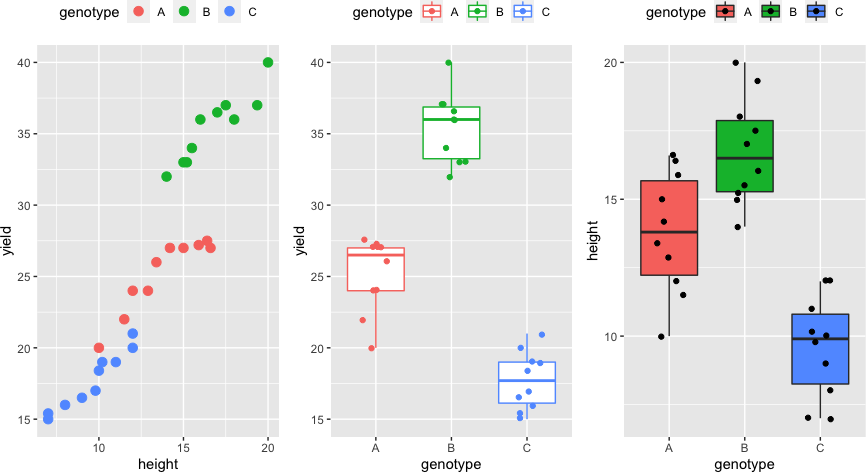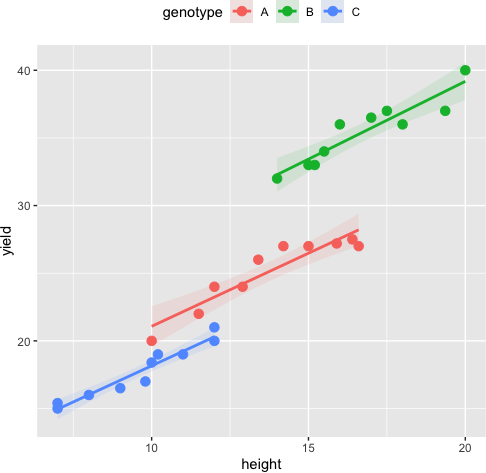Analysis of Covariance (ANCOVA) using R
Want to share your content on R-bloggers? click here if you have a blog, or here if you don't.
A general linear model (GLM) with at least one continuous and one categorical independent variable is known as ANCOVA (treatments). When the effect of treatments is essential and there is an additional continuous variable in the study, ANCOVA is effective. A covariate is an additional continuous independent variable in ANCOVA (also known as control, concomitant, or confounding variable). By statistically modifying the influence of the covariate, ANCOVA evaluates the differences between groups in a categorical independent variable (primary interest) (by removing the variance associated with covariate).
By reducing the variance associated with a covariate, ANCOVA improves statistical power and decreases error terms.
ANCOVA calculates adjusted means for each group in a categorical independent variable (which are statistically controlled for covariate). Adjusted means eliminating the model’s covariate bias. ANCOVA examines the adjusted effects of the independent variable on the dependent variable using a multiple regression method (similar to simple regression in ANOVA).
ANCOVA example
The following hypothetical example data consist of two independent variables viz. plant genotype (categorical) and plant genotype height (continuous). The yield of plant genotype is the dependent variable. The ANCOVA model analyzes the influence of plant genotypes on genotype yield whilst controlling the effect of the covariate. With ANCOVA, the effect of different genotypes on plant yield can be precisely analyzed while controlling the effect of plant height.
Assumptions of ANCOVA
ANCOVA follows similar assumptions as in ANOVA for the independence of observations, normality, and homogeneity of variances
In addition, ANCOVA needs to meet the following assumptions,
- Linearity assumption: At each level of categorical independent variable, the covariate should be linearly related to the dependent variable. If the relationship is not linear, the adjustment made to covariate will be biased.
- Homogeneity of within-group regression slopes (parallelism or non-interaction): There should be no interaction between the categorical independent variable and covariate i.e. the regression lines between the covariate and dependent variable for each group of the independent variable should be parallel (same slope).
- Dependent variable and covariate should be measured on a continuous scale
- Covariate should be measured without error or as little error as possible
One-way (one factor) ANCOVA in R
In one-way ANCOVA, there are three variables viz. one independent variable with two or more groups, dependent, and covariate variables
ANCOVA Hypotheses
- Null hypothesis: Means of all genotypes yield are equal after controlling the effect of genotypes height i.e. adjusted means are equal
H0: μ1=μ2=…=μp - Alternative hypothesis: At least, one genotype yield mean is different from other genotypes after controlling the effect of genotypes height i.e. adjusted means are not equal
H1: All μ are not equal
Load the dataset
library(tidyverse)
df=read_csv("https://reneshbedre.github.io/assets/posts/ancova/ancova_data.csv")
head(df, 2)
# output
genotype height yield
<chr> <dbl> <dbl>
1 A 10 20
2 A 11.5 22
Summary statistics and visualization of dataset
Get summary statistics based on dependent variable and covariate,
library(rstatix) # summary statistics for dependent variable yield df %>% group_by(genotype) %>% get_summary_stats(yield, type="common") # output genotype variable n min max median iqr mean sd se ci <chr> <chr> <dbl> <dbl> <dbl> <dbl> <dbl> <dbl> <dbl> <dbl> <dbl> 1 A yield 10 20 27.5 26.5 3 25.2 2.58 0.815 1.84 2 B yield 10 32 40 36 3.62 35.4 2.43 0.769 1.74 3 C yield 10 15 21 17.7 2.88 17.7 2.04 0.645 1.46 # summary statistics for covariate height df %>% group_by(genotype) %>% get_summary_stats(height, type="common") # output genotype variable n min max median iqr mean sd se ci <chr> <chr> <dbl> <dbl> <dbl> <dbl> <dbl> <dbl> <dbl> <dbl> <dbl> 1 A height 10 10 16.6 13.8 3.45 13.8 2.22 0.704 1.59 2 B height 10 14 20 16.5 2.6 16.8 1.96 0.621 1.40 3 C height 10 7 12 9.9 2.55 9.6 1.84 0.582 1.32
Visualize dataset,
library(gridExtra) p1 <- ggplot(df, aes(height, yield, colour = genotype)) + geom_point(size = 3) + theme(legend.position="top") p2 <- ggplot(df, aes(x = genotype, y = yield, col = genotype)) + geom_boxplot(outlier.shape = NA) + geom_jitter(width = 0.2) + theme(legend.position="top") p3 <- ggplot(df, aes(x = genotype, y = height, fill = genotype)) + geom_boxplot(outlier.shape = NA) + geom_jitter(width = 0.2) + theme(legend.position="top") grid.arrange(p1, p2, p3, ncol=3)

perform one-way ANCOVA
anova_test(data = df, formula = yield ~ height + genotype, type = 3, detailed = TRUE) # type 3 SS should be used in ANCOVA
# output
ANOVA Table (type III tests)
Effect SSn SSd DFn DFd F p p<.05 ges
1 (Intercept) 78.071 17.771 1 26 114.220 5.22e-11 * 0.815
2 height 132.696 17.771 1 26 194.138 1.43e-13 * 0.882
3 genotype 193.232 17.771 2 26 141.353 1.07e-14 * 0.916
ANCOVA results indicate that there are significant differences in mean yield [F(2, 26) = 141.35, p < 0.001] among genotypes whilst adjusting the effect of genotype height.
The covariate height is significant [F(1, 26) = 194.13, p < 0.001] suggesting it is an important predictor of genotypes yield.
Get adjusted means,
adj_means <- emmeans_test(data = df, formula = yield ~ genotype, covariate = height) get_emmeans(adj_means) # output height genotype emmean se df conf.low conf.high method <dbl> <fct> <dbl> <dbl> <dbl> <dbl> <dbl> <chr> 1 13.4 A 24.7 0.263 26 24.2 25.3 Emmeans test 2 13.4 B 31.7 0.373 26 31.0 32.5 Emmeans test 3 13.4 C 21.9 0.397 26 21.1 22.7 Emmeans test
emmeans gives the estimated marginal means (EMMs) which is also known as least-squares means. EMMs are adjusted means for each genotype. The B genotype has the highest yield (31.7) whilst controlling the effect of height.
post-hoc test
From ANCOVA, we know that genotypes yield are statistically significant whilst controlling the effect of height, but ANCOVA does not tell which genotypes are significantly different from each other.
To know the genotypes with statistically significant differences, I will perform the post-hoc test with the Benjamini-Hochberg FDR method for multiple hypothesis testing at a 5% cut-off
emmeans_test(data = df, formula = yield ~ genotype, covariate = height, p.adjust.method = "fdr") # output term .y. group1 group2 df statistic p p.adj * <chr> <chr> <chr> <chr> <dbl> <dbl> <dbl> <dbl> 1 heig… yield A B 26 -16.0 5.32e-15 1.60e-14 2 heig… yield A C 26 5.71 5.21e- 6 5.21e- 6 3 heig… yield B C 26 14.6 4.89e-14 7.33e-14
The multiple pairwise comparisons suggest that there are statistically significant differences in adjusted yield means among all genotypes.
ANCOVA assumptions test
Assumptions of normality
The residuals should be approximately normally distributed. The Shapiro-Wilk test can be used to check the normal distribution of residuals. Null hypothesis: data is drawn from a normal distribution.
shapiro.test(resid(aov(yield ~ genotype + height, data = df))) # output Shapiro-Wilk normality test data: resid(aov(yield ~ genotype + height, data = df)) W = 0.96116, p-value = 0.3315
As the p-value is non-significant (p > 0.05), we fail to reject the null hypothesis and conclude that data is drawn from a normal distribution.
If the sample size is sufficiently large (n > 30), the moderate departure from normality can be allowed.
In addition, QQ plots and histograms can be used to assess the assumptions of normality
Assumptions of homogeneity of variances
The variance should be similar for all genotypes. Bartlett’s test can be used to check the
homogeneity of variances. Null hypothesis: samples from populations have equal variances.
bartlett.test(yield ~ genotype, data = df) # output Bartlett test of homogeneity of variances data: yield by genotype Bartlett's K-squared = 0.48952, df = 2, p-value = 0.7829
As the p-value is non-significant (p > 0.05), we fail to reject the null hypothesis and conclude that genotypes have equal variances.
Levene’s test can be used to check the homogeneity of variances when the data is not drawn from a normal distribution.
Assumptions of homogeneity of regression slopes (covariate coefficients)
This is an important assumption in ANCOVA. There should be no interaction between the categorical independent variable and covariate. This can be tested using interaction terms between genotype and height in ANOVA. If this assumption is violated, the treatment effect will not be the same across various levels of the covariate. At this stage, consider alternatives to ANCOVA such as Johnson Neyman Technique.
Anova(aov(yield ~ genotype * height, data = df), type = 3)
# output
Sum Sq Df F value Pr(>F)
(Intercept) 24.140 1 32.8418 6.629e-06 ***
genotype 6.756 2 4.5960 0.02042 *
height 52.014 1 70.7635 1.283e-08 ***
genotype:height 0.130 2 0.0887 0.91545
Residuals 17.641 24
As the p value is for interaction (genotype:height) is non-significant (p > 0.05), there is no interaction between genotype and height.
Assumptions of linearity
The relationship between the covariate and at each group of the independent variable should be linear. The scatterplot of covariate and dependent variable at each group of the independent variable can be used to assess this assumption. The data points should lie on the straight line to meet the linearity assumption.
ggplot(df, aes(height, yield, colour = genotype)) + geom_point(size = 3) +
geom_smooth(method = "lm", aes(fill = genotype), alpha = 0.1) + theme(legend.position="top")

The post Analysis of Covariance (ANCOVA) using R appeared first on Statistical Aid: A School of Statistics.
R-bloggers.com offers daily e-mail updates about R news and tutorials about learning R and many other topics. Click here if you're looking to post or find an R/data-science job.
Want to share your content on R-bloggers? click here if you have a blog, or here if you don't.
